The Islamic world has a long tradition of imaginatively designed incense burners made of metal (
48/1981). This specimen belongs to a distinctive type with a domed lid and a cylindrical body raised on three feet. The type was widespread in Syria, northern Iraq and Iran in the thirteenth and fourteenth centuries (
47/1967).
The outside of the incense burner is covered with well-preserved silver inlays. The background pattern consists of arabesques, in between which is a courtly scene presented in two tiers. The scene is centred around a seated prince holding a beaker, a traditional way of depicting Islamic rulers. More unusual are the courtiers arranged in rows above and around the prince. Several of these hold objects that can be linked to special titles used at the princely courts of the time.
[1] For example, the figure on the prince’s right side, holding a sword, must be his ‘sword bearer’ (
silahdar), while the figure on the prince’s left with a napkin in his hand and a bundle on his back is presumably his ‘master-of-the-robes’ (
jamdar), a figure whose area of responsibility included the robes of honour and other ceremonial textiles. Further back you can also see the prince’s ‘bow bearer’ (
bunduqdar) and his ‘polo stick bearer’ (
jukandar).
Several of the other figures in the friezes carry animals. Three stand with birds that might be falcons, two are holding lambs, while yet another two are carrying peacocks with long, wavy tail feathers. These imposing birds were a favourite symbol of power, and two similar peacocks appear, for example, on a lid from a ewer dating from second half of the thirteenth century (
39/2008).
On the domed lid of this incense burner, the frieze is interrupted by three riveted plates with openwork, silver-inlaid arabesques. Such plates are not known from any other incense burners, but the well-proportioned, light and airy expression of the arabesques is typical of the art of thirteenth-century Iraq and Syria (
12/2020). On the body, opposite the seated prince, is a cartouche with flimsy engraved arabesques of inferior quality compared to the rest of the decoration. These were added later and indicate where the original horizontal handle, now lost, was mounted.
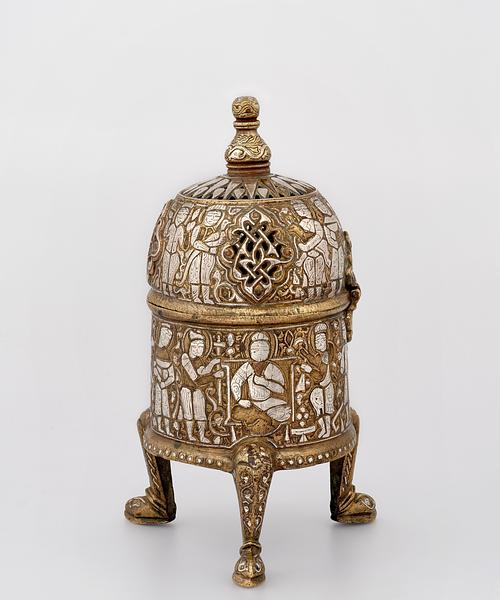.-The-David-Collection_Copenhagen_Photo-Pernille-Klemp.jpg?locale=en)
.-The-David-Collection_Copenhagen_Photo-Pernille-Klemp.jpg?locale=en)
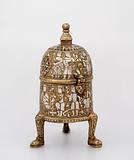.-The-David-Collection_Copenhagen_Photo-Pernille-Klemp.jpg?locale=en)
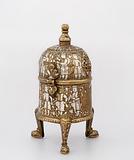.-The-David-Collection_Copenhagen_Photo-Pernille-Klemp.jpg?locale=en)
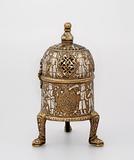.-The-David-Collection_Copenhagen_Photo-Pernille-Klemp.jpg?locale=en)
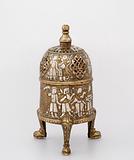.-The-David-Collection_Copenhagen_Photo-Pernille-Klemp.jpg?locale=en)
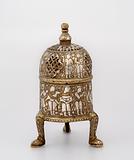.-The-David-Collection_Copenhagen_Photo-Pernille-Klemp.jpg?locale=en)
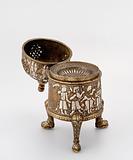.-The-David-Collection_Copenhagen_Photo-Pernille-Klemp.jpg?locale=en)